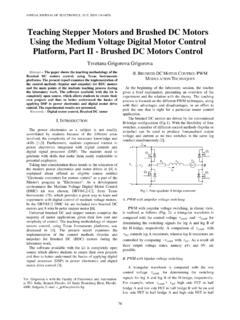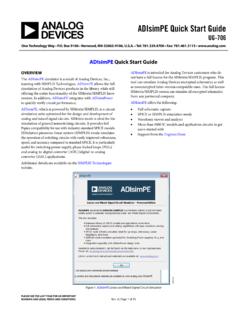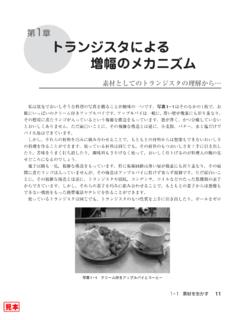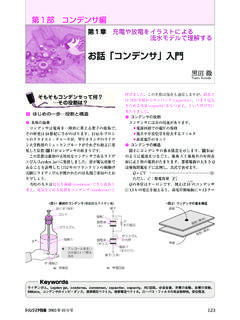Transcription of Teaching PLL Fundamentals Using MATLAB/Simulink
1 ANNUAL JOURNAL OF ELECTRONICS, 2014, ISSN 1314-0078. Teaching PLL Fundamentals Using MATLAB/Simulink Daniela Antonova Shehova and Peter Ivanov Yakimov Abstract PLL is employed in a wide array of electronic supports simulation, automatic code generation, and and communications equipment and understanding its continuous test and verification. Simulink provides a principles is of a great importance. Simulation is an obvious graphical editor, customizable block libraries, and solvers solution for Teaching PLL Fundamentals . MATLAB/Simulink for modeling and simulating dynamic systems. It is is a very powerful block simulation environment, most capable for PLL.
2 The paper discusses an approach for integrated with MATLAB , enabling incorporation Teaching enabling the students to obtain sustainable MATLAB algorithms into models and exportation knowledge about PLL. simulation results to MATLAB for further analysis. Keywords PLL, Simulink, MATLAB, simulation, Teaching MATLAB Simulink is a very powerful block simulation environment, most capable for PLL. Simulink behavioral I. INTRODUCTION simulation is much faster than circuit-level simulation, and as a result, there can be completed many simulations in one day, experimenting with different implementation ideas for Phase-locked loop (PLL) is a feedback loop which locks the functional blocks.
3 The behavioral simulations are two waveforms with same frequency but shifted in phase instrumental in determining the block-level specifications [1]. The fundamental use of this loop is in comparing that will satisfy a given set of top-level PLL specifications. frequencies of two waveforms and then adjusting the frequency of the waveform in the loop to equal the input waveform frequency. Used to synchronize the phase of two II. BASIC BLOCKS MODEL PARAMETERS SETTING. signals, the PLL is employed in a wide array of electronic and communications equipment, including microprocessors A. Pulse Generator devices such as radios, televisions, and mobile phones.
4 The basic blocks of the PLL are a phase detector, a low-pass The Pulse Generator block generates the reference filter, a variable frequency oscillator, and a divider (Fig. 1). signal. It produces a periodic pulse train. The variable synFr denotes the frequency of the pulse train. The period of the pulse train is 1/synFr. To change the value of the period, the value of the variable synFr has to be changed so that the new value of synFr is used in all the blocks whose parameters reference the variable synFr (Fig. 2). Fig. 1. PLL general block diagram. Obtaining sustainable knowledge about PLL requires understanding its Fundamentals - loop components, loop response, loop stability, transient response, modulation response.
5 Simulation is an obvious solution. Most often MATLAB will suffice for modeling and simulation. The use of Spice with behavioral level modeling capabilities may also be useful, , XSpice via SIMetrix/SIMPLIS or PSpice. Simulink is a block diagram environment for multidomain simulation and Model-Based Design [4]. It Fig. 2. Pulse generator model parameter setting. D. Shehova is with the Technical College by Plovdiv University Paisiy Hilendarski , 4700 Smolyan, Bulgaria, e- mail: B. Divide Frequency subsytems P. Yakimov is with the Department of Electronics, Faculty of Electronic Engineering and Technologies, Technical University There are two divide frequency subsystems - divide of Sofia, 8 Kl.
6 Ohridski Blvd, Sofia 1000, Bulgaria, e-mail: frequency by synM and divide frequency by synN. The 139. ANNUAL JOURNAL OF ELECTRONICS, 2014. divide frequency by synM subsystem divides the frequency approximately constant, with a value of This is the of the reference signal by the variable synM. The output of average value of the output from the phase detector. the block is a pulse train called the frequency-divided A Gain block multiplies the output signal from the reference signal. This value determines the step of the Analog Filter Design block by a constant to produce the output frequency setting. The divide frequency by synN control signal.
7 Subsystem divides the frequency of the synthesized signal by the variable synN. The output of this subsystem is called the frequency-divided synthesized signal. At steady state its frequency has the same value as the output one of the synM. subsystem. The value of the divisor in these subsystems can be changed by changing the value of synM or synN. (Fig. 3). Fig. 5. Analog filter design menu. E. Voltage-Controlled Oscillator Fig. 3a. SynM value setting. The Continuous-Time VCO block generates the synthesized signal (along with the Convert to Square Wave subsystem) and adjusts the frequency of the synthesized signal according to the Voltage-Controlled Oscillator input signal.
8 When the control signal is close to its steady-state, the Continuous-Time VCO block generates a signal whose frequency is close to synFr*synN/synM. If the output frequency drops, the control signal rises, boosting the frequency of the output signal. If the output frequency Fig. 3b. SynN value setting. rises, the control signal falls, lowering the output frequency. The Quiescent frequency parameter is just the C. Phase Detector oscillation frequency, synFq. The difference between the block's output signal frequency and the quiescent The Logical Operator block acts as a phase detector. It frequency is proportional to the input signal, interpreted as uses the XOR operation to compare the frequencies of the voltage.
9 The quiescent frequency is set to the variable frequency-divided reference signal and the frequency- synFq. This value can be changed in the quiescent divided synthesized signal. At steady state, the signal is a frequency field, or by changing the value of synFq in the pulse train with frequency two times higher than the both base MATLAB workspace (Fig. 6). inputs. The reason for this is that both inputs to the block have equal frequencies, but they are out of phase by 1/4 of their period. As a result, the signal after the XOR operation is a periodic pulse train with double frequency (Fig. 4). Fig. 4. Phase detector parameters setting.
10 Fig. 6. VCO parameters setting. D. Analog Filter Design III. STUDY OF FRACTIONAL-N FREQUENCY. The Analog Filter Design block filters high frequencies out of the signal coming from the phase detector. The block SYNTHESIS. uses a lowpass Butterworth filter. A higher-order filter or As an example a study of a fractional-N frequency another filter type can be used to improve the stability of synthesis (Fig. 7) is chosen to explain the students the the synthesized signal (Fig. 5). In the steady state of the operation of PLL and to give them skills for work with model, the amplitude of the block's output signal is MATLAB/Simulink [2].




